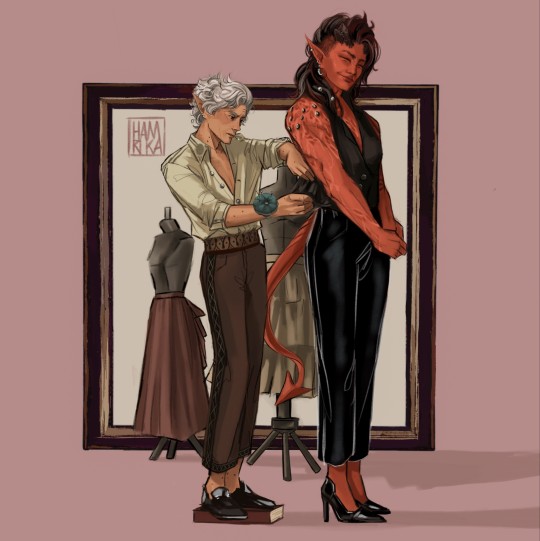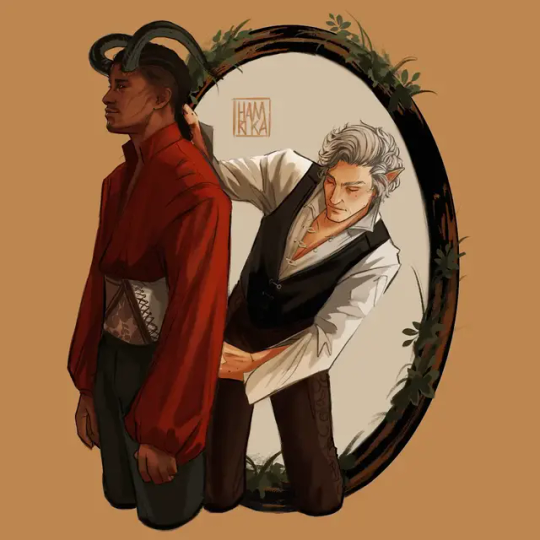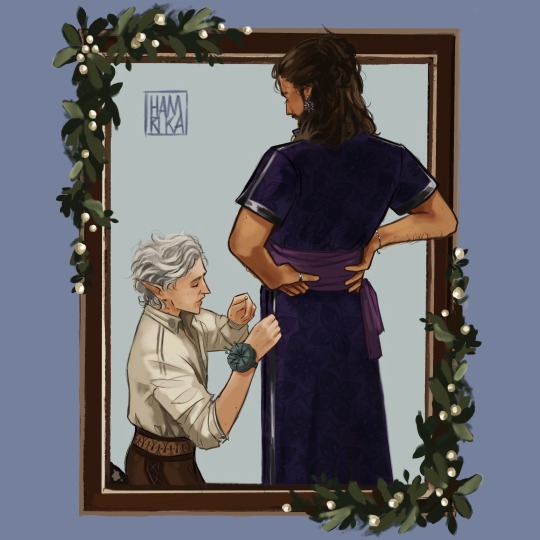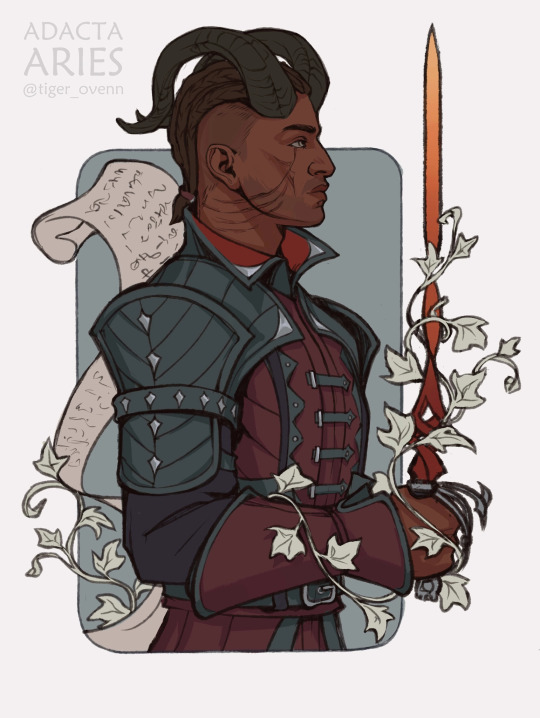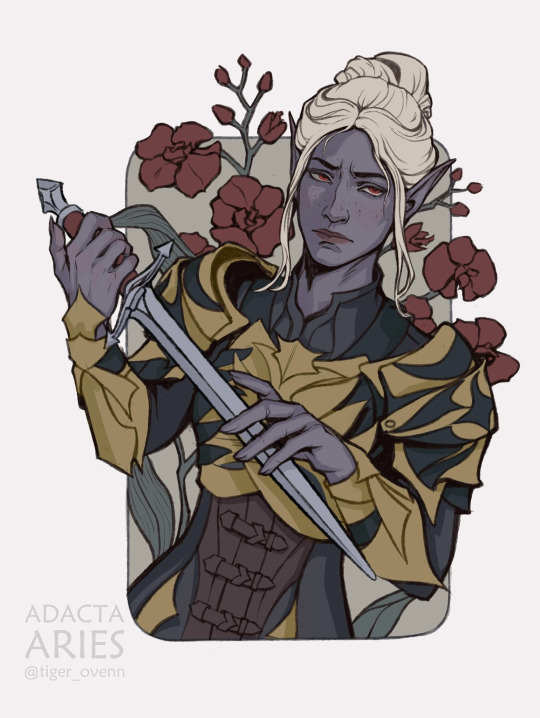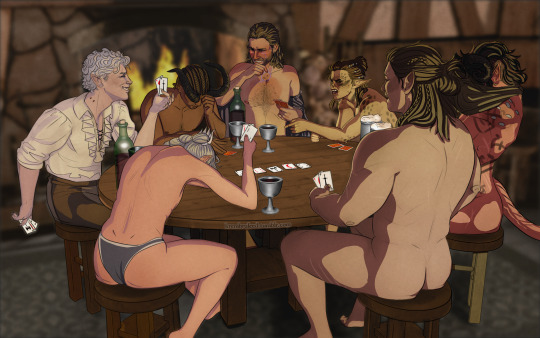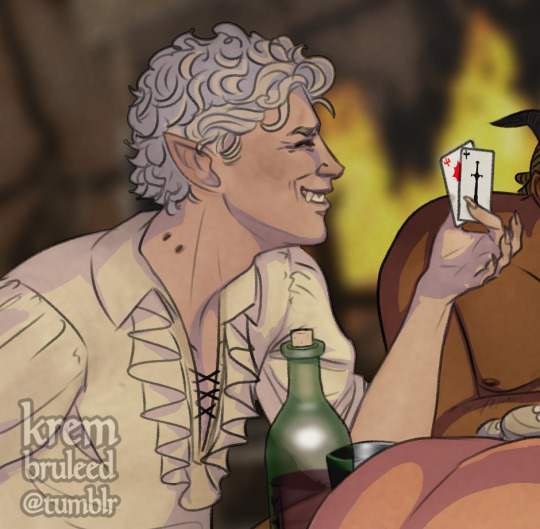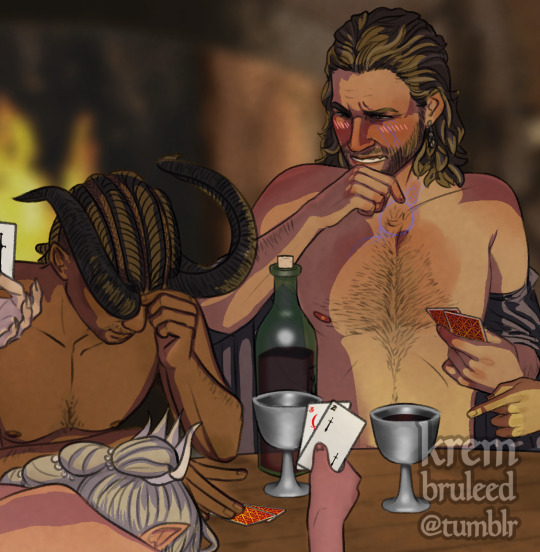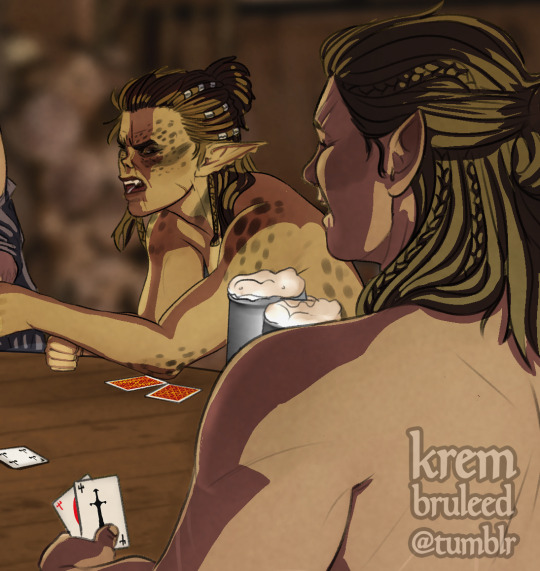Text
A fairly good general reference video about historical/traditional fashion of various cultures and peoples (including hanfu, but not just hanfu) that have been part of Chinese history:
youtube
The video is arranged in chronological order, below are the timestamps:
0:24 - Warring States period/战国 hanfu (for those who don't know: hanfu/汉服 is the historical and traditional outfits of Han people/汉族)
1:16 - Western Han dynasty/西汉 hanfu
2:11 - Jingjue Kingdom/精绝 and Loulan Kingdom/楼兰 historical outfits
2:45 - Eastern Han dynasty/东汉 to Three Kingdoms period/三国 hanfu
3:51 - Northern Dynasties/北朝 Xianbei/鲜卑 historical outfits
4:46 - Southern Dynasties/南朝 hanfu
5:25 - Sui dynasty/隋 hanfu
5:56 - Tang dynasty/唐 hanfu
6:38 - Sogdian/粟特 historical outfits
6:59 - Tubo Empire/吐蕃 Tibetan/藏族 historical outfits
7:38 - Huihu/回鹘 historical outfits (Qocho Huihu Kingdom/高昌回鹘 and Ganzhou Huihu Kingdom/甘州回鹘; note: Huihu people are the ancestors of the modern Uyghur people/维吾尔族)
8:21 - Nanzhao Kingdom/南诏 historical outfits (of the ancestors of the modern Yi people/彝族 and Bai people/白族)
9:07 - Five Dynasties/五代 hanfu
9:57 - Northern Song dynasty/北宋 hanfu
10:38 - Liao dynasty/辽 Khitan/契丹 historical outfits
11:21 - Jin dynasty/金 Jurchen/女真 historical outfits
12:07 - Western Xia/西夏 Tangut/党项 historical outfits
12:37 - Dali Kingdom/大理 historical outfits (of the ancestors of the modern Bai people/白族)
13:20 - Southern Song dynasty/南宋 hanfu
14:00 - Yuan dynasty/元 Mongolian/蒙古族 historical outfits
14:58 - Yuan dynasty women's hanfu
15:24 - Ming dynasty/明 hanfu
16:24 - Qing dynasty/清 Manchu/满族 traditional outfits
16:59 - Qing dynasty Han women's outfit
**Note: as mentioned by the OP, due to the lack of suriviving physical artifacts for some time periods/cultures/kingdoms/dynasties, there is a certain amount of speculation in this video based on other artifacts/records like wall murals, paintings, figurines, and historical records.
593 notes
·
View notes
Text
April 20, Beijing, China, National Museum of China/中国国家博物馆 (Part 1 - Dehua white porcelain exhibition/德化白瓷展):
Aaand finally, the National Museum of China/中国国家博物馆! I was lucky enough to see the famed Dehua white porcelain exhibition/德化白瓷展 here. Some of you may recognize some of these pieces already, since pictures and shorts of them have been circulating online way before I went on this trip, but there are many many other pieces too. The pieces I post here are only a small portion of the entire exhibition, so if you ever get a chance to see the exhibition elsewhere in person, don't hesitate. This stuff is amazing.
First up is one of the two that has been gaining popularity online, the piece named 神话 or "Legend".
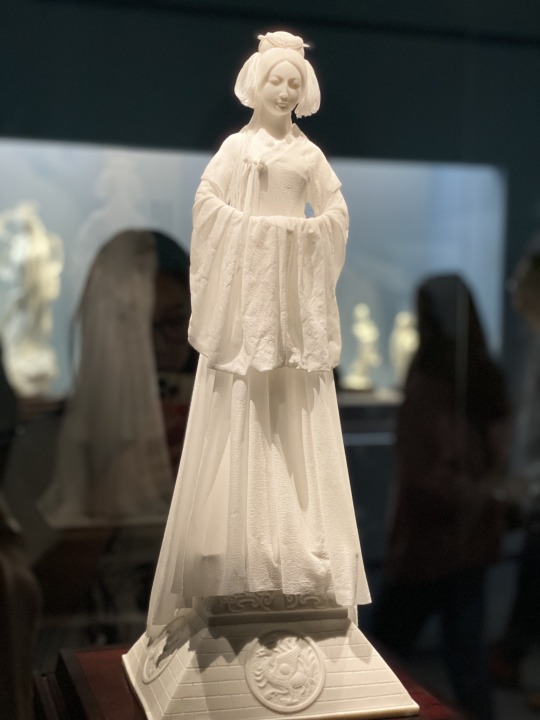
The first time I saw a porcelain piece like this, I thought that the clothing part was made with paper? But no, the light fabric of the clothing, the hair, it's all porcelain. Keep in mind when looking through these pictures: every part of every piece is porcelain.
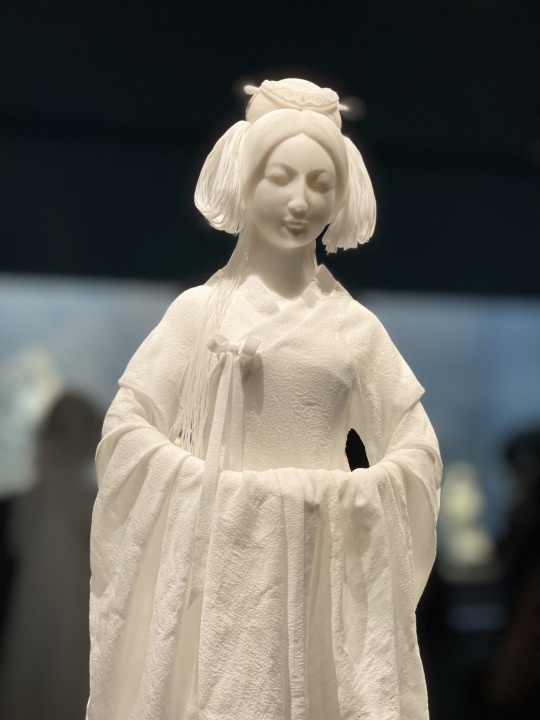
This piece is the other one that was becoming popular, the piece named simply 纸, or "Paper". If you don't look up close and see the glossy surface, you can't tell it's actually porcelain. I cannot for the life of me imagine the kind of magic that was used to turn clay into this
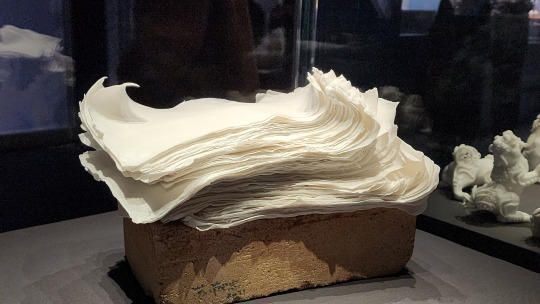
Anyway, this is a good point to introduce Dehua porcelain a little bit. Dehua porcelain is a regional specialty of Dehua/德化, which is located in Fujian province, and is known for its expressiveness and white color. For this reason it's also known in the West as "Blanc de Chine" (French: "white of China"), and this should be the reason why this exhibition is named 中国白, which basically means the same thing. The history of Dehua porcelain goes back to Song dynasty (960 - 1279), and it is still being produced today. Many of the pieces I'm posting here are modern pieces.

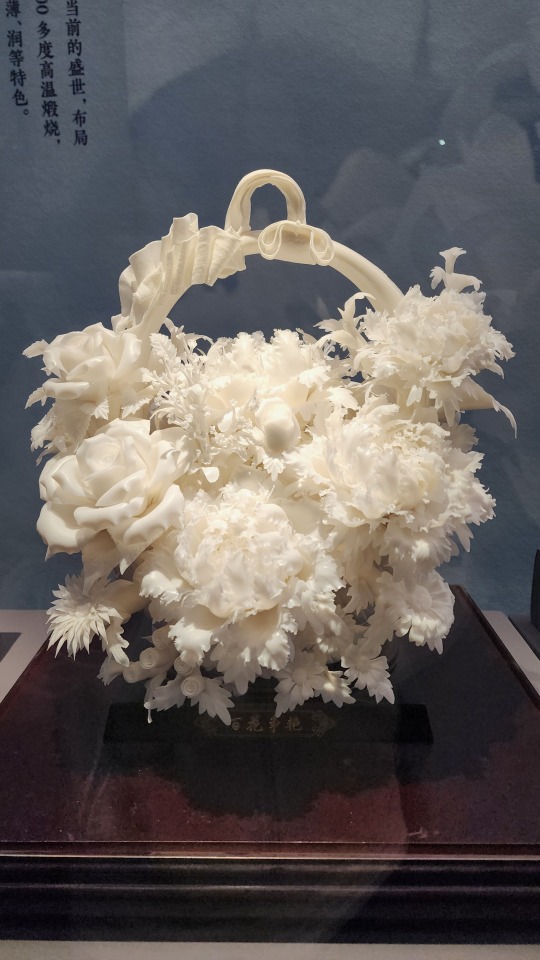
But Dehua white porcelain can be colored too (I imagine the color must be painted on later, because the white comes from the clay itself), and when it is colored, it looks like it came right out of a painting

This piece is especially amazing to me. Look at the texture, look at those details. Zoom in and you will find that there are actually a bunch of porcelain ants on this porcelain tree stump. Porcelain ants. I never expected to use porcelain as an adjective when describing ants. Wtf. It's like a manifestation of a scene from an older animated movie.
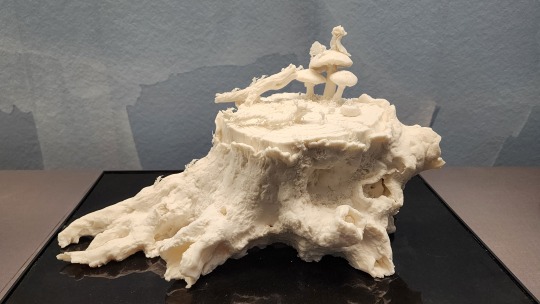
Peanuts are called 花生 in Chinese, which literally means "flower grow", and because it also has a long shelf life, it symbolizes longevity and a happy marriage. Also a fun fact: because Watson of Sherlock Holmes is usually phoenetically translated as 华生 (huá shēng) in Chinese and sounds similar to 花生 (huā shēng), you will find that many in the Chinese SH fandom refers to Watson as "peanut".

This piece is titled 春色满园, or "garden filled with spring scenery". This is also a common 4-character word used to describe gardens in spring. I'm guessing the figure depicted here is one of the flower gods. It is one of my personal favorites because of its superb depiction of movement, it's as if the flower god will really fly away on clouds at any moment

More depictions of traditional Chinese deities, specifically Chang'e/嫦娥, the moon goddess. That moon rabbit is too cute.


Depictions of what I'm assuming is the Four Heavenly Kings/四大天王, based on the items they are holding. The Four Heavenly Kings are Buddhist deities.

Look at her clothing! That porcelain is so thin it's almost see-through! Also is it depicting Li Qingzhao/李清照, the famous female poet from Song dynasty? She does have a famous ci poem that's about paddling a boat in a lake full of lotuses while drunk

The piece titled 锦绣前程, or "future as vibrant and prosperous as silk brocade". This is also a common 4-character word used in well wishing. The figure in this piece is holding a xiuqiu/绣球, a ball made of silk, which was usually seen as a token of love


Somewhat more modern-themed pieces:
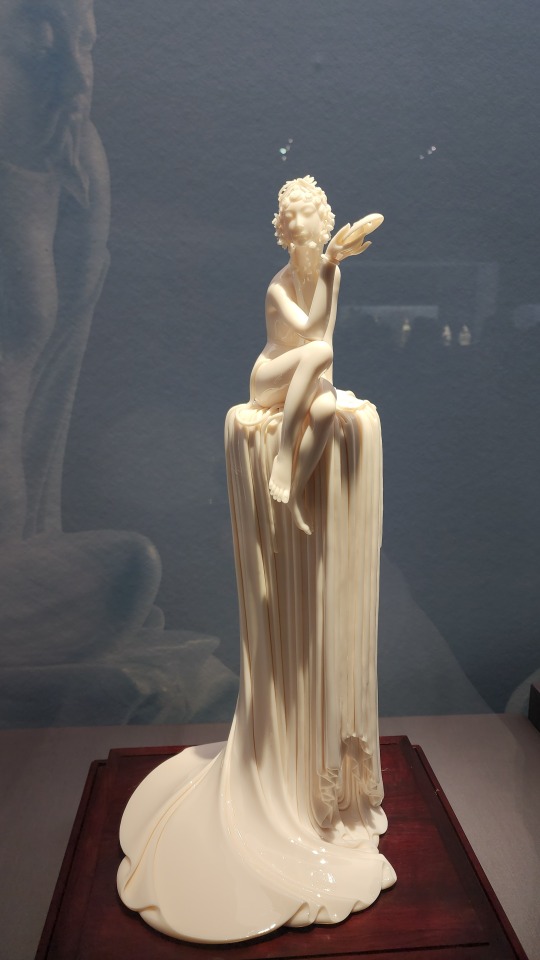

Among the hundreds of amazing pieces, this one caught my attention for its unique texture. When everyone else was trying to turn the clay into these thin sheets representing fabric or paper or flower petals, this artist took the noodle approach. Not many visitors seemed to like it, but I think it's pretty cool

Piece titled 运势如虹, or "fortune like the rainbow", also a 4-character word used in well wishing. Traditionally horses symbolize vitality and success, hence why many people use the words 马到成�� ("horse's arrival brings success") and 龙马精神 ("vitality of dragons and horses") in well wishes during Year of the Horse

Stay tuned for Part 2 of the Dehua white porcelain exhibition!
4K notes
·
View notes
Text

weird courtship dance between a cat and a snake
799 notes
·
View notes
Text
Quick what are you doing RIGHT now (besides scrolling Tumblr)
88K notes
·
View notes
Text
A fairly good general reference video about historical/traditional fashion of various cultures and peoples (including hanfu, but not just hanfu) that have been part of Chinese history:
youtube
The video is arranged in chronological order, below are the timestamps:
0:24 - Warring States period/战国 hanfu (for those who don't know: hanfu/汉服 is the historical and traditional outfits of Han people/汉族)
1:16 - Western Han dynasty/西汉 hanfu
2:11 - Jingjue Kingdom/精绝 and Loulan Kingdom/楼兰 historical outfits
2:45 - Eastern Han dynasty/东汉 to Three Kingdoms period/三国 hanfu
3:51 - Northern Dynasties/北朝 Xianbei/鲜卑 historical outfits
4:46 - Southern Dynasties/南朝 hanfu
5:25 - Sui dynasty/隋 hanfu
5:56 - Tang dynasty/唐 hanfu
6:38 - Sogdian/粟特 historical outfits
6:59 - Tubo Empire/吐蕃 Tibetan/藏族 historical outfits
7:38 - Huihu/回鹘 historical outfits (Qocho Huihu Kingdom/高昌回鹘 and Ganzhou Huihu Kingdom/甘州回鹘; note: Huihu people are the ancestors of the modern Uyghur people/维吾尔族)
8:21 - Nanzhao Kingdom/南诏 historical outfits (of the ancestors of the modern Yi people/彝族 and Bai people/白族)
9:07 - Five Dynasties/五代 hanfu
9:57 - Northern Song dynasty/北宋 hanfu
10:38 - Liao dynasty/辽 Khitan/契丹 historical outfits
11:21 - Jin dynasty/金 Jurchen/女真 historical outfits
12:07 - Western Xia/西夏 Tangut/党项 historical outfits
12:37 - Dali Kingdom/大理 historical outfits (of the ancestors of the modern Bai people/白族)
13:20 - Southern Song dynasty/南宋 hanfu
14:00 - Yuan dynasty/元 Mongolian/蒙古族 historical outfits
14:58 - Yuan dynasty women's hanfu
15:24 - Ming dynasty/明 hanfu
16:24 - Qing dynasty/清 Manchu/满族 traditional outfits
16:59 - Qing dynasty Han women's outfit
**Note: as mentioned by the OP, due to the lack of suriviving physical artifacts for some time periods/cultures/kingdoms/dynasties, there is a certain amount of speculation in this video based on other artifacts/records like wall murals, paintings, figurines, and historical records.
593 notes
·
View notes
Text

"....She touched a dagger to my eye, drawing a tear of blood. 'I want this one' she said."
5K notes
·
View notes
Text

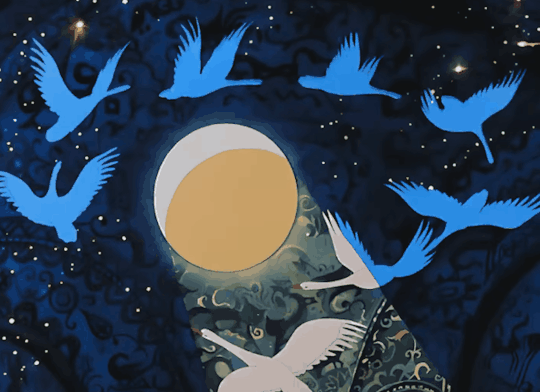

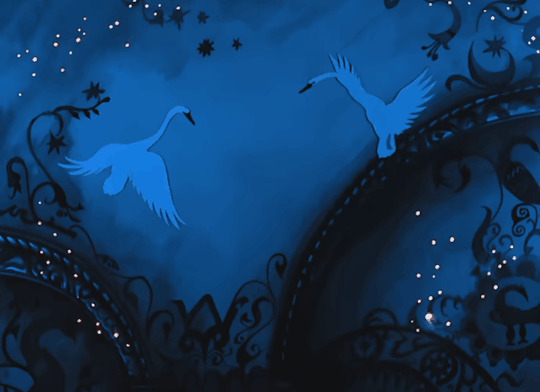
The Frog Princess (Царевна-лягушка)
Soyuzmultfilm, 1954
[eng sub] [HD on vk]
6K notes
·
View notes
Text
I love how humans have literally not changed throughout history like the graffiti from Pompeii has people from hundreds of years ago writing stuff like “Marcus is gay” “I fucked a girl here” “Julius your mum wishes she was with me” and leonardo da vinci’s assistants drew dicks in their notebooks just for the banter and mozart created a piece called “kiss my ass” so when people wish for ‘today’s generation’ to be like ‘how people used to’ then we’re already there buddy we’ve always been
1M notes
·
View notes
Text
Psst, hey you, yeah you. Could you put in a reblog or in the tags one small fact about your Sidestep? Nothing groundbreaking, something as simple as color preference or their favorite food. Any little thing. I just wanna know. Ok, thanks.🧡
#my og sidestep is colorblind and in denial#she dropped the “green is the color of sand” line and explained her awfull color combination outfits#of course she see blues perfectly
178 notes
·
View notes
Text

Made this last year. Pinup versions of Baldurs Gate 3 ladies.
2K notes
·
View notes
Text

Halsin bore down on Clover-- heavy, insistent. A pleading sweetness about Clover's scent told Halsin he was in need and his whole body wanted to provide.
Full nsft on Patreon ❄️🦌
677 notes
·
View notes



